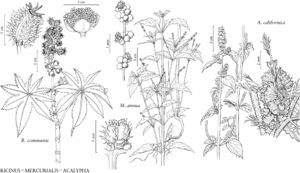Ricinus communis
Sp. Pl. 2: 1007. 1753.
Plants 1–4 [–5+] m. Stems erect. Leaves: stipules 2–3 cm, connate, leaving conspicuous scar around stem; petiole 10–55 cm, with (0–) 1–3 cuplike glands on proximal adaxial surface, 2 glands at apex adaxially; blade circular in outline, 15–50 cm diam., base peltate, marginal teeth gland-tipped, laminar glands scattered on adaxial surface, lobes 7–12, lanceolate or oblanceolate, increasing in size apically, apex narrowly acute to acuminate. Inflorescences 6–30 cm, to 45 cm in fruit; bracts caducous except for 2 persistent glands. Pedicels: staminate 5–15 mm; pistillate 0.5–5 mm, elongating to 40 mm in fruit. Staminate flowers: calyx lobes ovate, 7–8 mm; stamen cluster ± spheric, 10–12 mm diam. Pistillate flowers: sepals ovate, 4–5 mm; ovary densely covered in slender-conic, bristle-tipped outgrowths; styles red or orange-red, 4–5 mm; stigmas distinctly spreading, papillose. Capsules dark red, echinate, subglobose, 1.5–2 cm diam. Seeds mottled brown, 8–11 mm, shiny. 2n = 20.
Phenology: Flowering and fruiting summer–late fall.
Habitat: Waste ground, riverbanks, sand and gravel bars, ravines, margins of cultivated fields, roadsides, along railways.
Elevation: 0–700 m.
Distribution
Introduced; Ala., Ariz., Ark., Calif., Fla., Ga., La., Miss., Mo., Tex., Africa, also in Mexico, West Indies, Bermuda, Central America, South America, Eurasia, Atlantic Islands, Indian Ocean Islands, Pacific Islands, Australia
Discussion
Ricinus communis, native to northeastern Africa, is cultivated as an ornamental throughout subtropical and temperate North America and is naturalized in the southern United States. It has been reported throughout the eastern United States as far north as Michigan and New Hampshire, and north to Utah and Kansas farther west, but appears to be a nonpersisting garden escape that is only adventive and not naturalized in these areas. In Missouri, it is considered to be naturalized (and uncommon) only in the extreme southeastern corner. Plants are shrubs in tropical and subtropical regions and very large annual herbs in cooler regions. Numerous horticultural cultivars exist, including some with dark red stems and leaves that are commonly planted in North America.
All plant parts are poisonous due to the water soluble protein ricin. In tropical regions (mainly Brazil and India), the species is widely cultivated for its seed oil. Castor oil, derived from the seeds (highly refined oil does not contain ricin), is used in cosmetics, medicines, paints, plastics, and lubricants. The use of castor oil in traditional medicine dates at least from ancient Egyptian times. Castor oil is used worldwide for a variety of medicinal purposes, most commonly as a laxative and for skin ailments. In North America, it was formerly commonly given to children as a general cure-all for internal ailments.
Selected References
None.
Lower Taxa
"elongating" is not a number."connate" is not a number. "distinct" is not a number.
